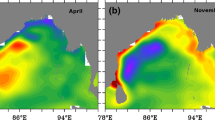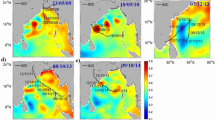Summary
A simple 1.5 layer reduced gravity transport model is used to understand the influence of a moving tropical cyclone on the upper layer of the Bay of Bengal. The wind stress used to force the model is derived from an idealised cyclone. The model cyclone is considered to be a symmetric vortex with both tangential and radial winds. The cyclone center moves northwestwards between the points 97E, 8N and 82E, 23N. In the control experiment, the cyclone is allowed to move the total distance in 5 days. The oceanic response is asymmetric in contrast to the symmetric wind forcings. Right bias found in the maxima of model circulation and upper layer thickness deviations, is in agreement with other modelling studies.
Fifteen sensitivity experiments are carried out by varying the intensity, size and speed of the cyclone, by changing the model parameters and with different initial conditions. Model fields show linear response to changes in the intensity and size of the cyclone. The changes in the maximum wind of the cyclone produces highest variability in the model fields. Increase in model resolution in association with the corresponding decrease in viscosity results in the enhancement of maxima of the flow magnitude and ULTD. Increasing the phase speed of the initial mode results in a wider spreading of energy and hence decrease in the flow intensity and the upper layer deviations. Model results do not show much variation by considering different initial conditions.
Similar content being viewed by others
References
Behera, S. K., Salvekar, P. S., 1995: A numerical modelling study of the interannual variability in the Indian Ocean.Mausam,46(4), 409–422.
Behera, S. K., Salvekar, P. S., 1996: Development of simple reduced gravity ocean model for the study of upper North Indian Ocean. IITM Research Report No. RR-072.
Camerlengo, A. L., O'Brien, J. J., 1980: Open boundary conditions in rotating fluid.J. Comp. Phys.,35, 12–35.
Chang, S. W., Anthes, R. A., 1978: Numerical simulations of the ocean's nonlinear, baroclinic response to translating hurricanes.J. Phys. Oceanogr.,8, 468–480.
DeMaria, M., 1985: Tropical cyclone motion in a nondivergent barotropic model.Mon. Wea. Rev.,113, 1199–1210.
DeMaria, M., Kaplan, J., 1994: Sea surface temperature and the maximum intensity of Atlantic tropical cyclone.J. Climate,7, 1324–1334.
Geisler, J. E., 1970: Linear theory of the response of a two layer ocean to a moving hurricane.Geophys. Fluid Dyn.,1, 249–272.
Greatbatch, R. J., 1983: On the response of the ocean to a moving storm: The nonlinear dynamics.J. Phys. Oceanogr.,13, 357–367.
Greatbatch, R. J., 1984: On the response of the ocean to a moving storm: Parameters and scales.J. Phys. Oceanogr.,14, 59–78.
Nilsson, J., 1996: Mixing in the ocean produced by tropical cyclone.Tellus,48 A, 342–355.
Price, J. F., Mooers, C. N. K., Leer, J. C. V., 1978: Observation and simulation of storm induced mixed layer deepening.J. Phys. Oceanogr.,8, 2–599.
Price, J. F., 1983: Internal wave wake of a moving storm: Part I, Scales, energy budget and observations.J. Phys. Oceanogr.,13(6), 949–965.
Thu, T. V., Krishnamurti, T. N., 1992: Vortex initialization for typhoon track prediction.Meteorol. Atmos. Phys.,47, 117–126.
Author information
Authors and Affiliations
Additional information
With 9 Figures
Rights and permissions
About this article
Cite this article
Behera, S.K., Deo, A.A. & Salvekar, P.S. Investigation of mixed layer response to Bay of Bengal cyclone using a simple ocean model. Meteorl. Atmos. Phys. 65, 77–91 (1998). https://doi.org/10.1007/BF01030270
Received:
Revised:
Issue Date:
DOI: https://doi.org/10.1007/BF01030270




